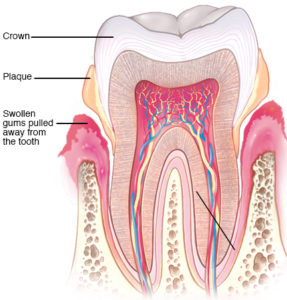Header logo
header top contact widget
Asheville dental specialist
Gag Reflex? Some Tips To Help.
Posted on Sep 04, 2019 by William J. Claiborne, DDS MS
For people who have a sensitive gag reflex, going to the dentist can be a trying experience. After all, the suction tube that removes water spray and saliva accumulating in the back of the mouth can trigger it. Once activated, gagging becomes all the more likely.
A gag reflex is a protective reaction that helps prevent foreign bodies from entering the trachea. While gagging is an involuntary and natural response, over thirty percent of otherwise healthy adults have an abnormal gag reflex.
For those who have a severe gag reflex, the mere thoughts of a suction tube or having a dental impression taken can create both dread and fear of embarrassment. After all, gagging triggers a spasm, which causes some people to have dry heaves or even regurgitate. Gagging may also be caused by acid reflux. For some, it can be triggered by certain smells and even anxiety.
Having a severe gag reflex is nothing to be ashamed of; it’s a common occurrence. If you feel this is a concern, feel free to mention this prior to any procedure (including dental cleanings). If you have avoided dental care because of gagging worries, we can discuss ways to help minimize the response and make procedures more comfortable.
The tips offered below may also help you reduce the severity of your gagging reflex as well.
• Breathe through your nose – Breathing through the nose can alter your focus from the potential to gag. Some patients find it beneficial to count their breaths to distract their minds. Breathing through the nose can also help your ability to relax. Concentrate on taking deep breaths in and out as you relax the jaw muscles.
• Go to your ‘happy place’ – When the fear of gagging is replaced by pleasant thoughts, patients are less likely to gag or the severity of the reflex is reduced. Think about things and people who make you happy. Your grandchildren? Your best friend? Relive a terrific vacation in your mind. Relaxing on a beach? Hiking a beautiful mountain? Think about foods that bring back memories. Peach cobbler with ice cream melting on top?
• Occupy your mind with tasks – A great distraction is to think of to-do’s in our head. For example, make a grocery list or the birthdays you need to remember for the next few months. The goal is to take your focus away from what’s going on in your mouth.
• Ask about sedation options – Having a severe gagging reflex may be helped greatly with an added sedative. In our Asheville periodontal office, we offer oral and IV sedation. Oral sedation is in pill form and has a quick recovery. I.V. sedation (referred to often as twilight sleep), provides a deeper level of sedation.
• Know you can take a break – Our patients are not prisoners in a chair, at any point – We realize some procedures can be long and are happy to provide a break to sit up, or move your mouth around, or get up and walk around. An opportunity to move your head and neck muscles around may revive you and provide just the relaxation you need.
• Don’t think of drooling as awkward – Saliva is a natural flow of moisture in the mouth. Drool is simply saliva that gets past the lips. As dental professionals, drool is not something that bothers us If drooling helps to relax your gag reflex, then go for it. If you do, we’ll help keep you comfy with suction and dabbing with tissues as needed.
Remember, gagging is rather common occurrence in a dental office. If gagging has caused you to avoid or delay having regular dental care or lengthy procedures, consider scheduling a consultation appointment in our beautiful Asheville periodontal dental office.
Call 828-274-9440 to schedule.
Men Have Greater Risks For Dental Problems.
Posted on Aug 20, 2019 by William J. Claiborne, DDS MS
Research has found that periodontal disease is higher in men (56.4 percent) than in women (38.4 percent). https://www.perio.org/consumer/gum-disease-and-men
 The reason for this significantly higher number may be due to some findings revealed through some unsettling findings. According to a survey by the Centers For Disease Control & Prevention (CDC), only 66 percent of males brush their teeth twice or more a day compared with 86 percent of females who do so.
The reason for this significantly higher number may be due to some findings revealed through some unsettling findings. According to a survey by the Centers For Disease Control & Prevention (CDC), only 66 percent of males brush their teeth twice or more a day compared with 86 percent of females who do so.
This was revealed through a study of over 800 participants. Evaluation included a written questionnaire on dental knowledge and oral health habits. It also included an oral exam of each participant to detect signs of periodontal disease. (https://www.perio.org/consumer/gender-differences)
Flossing had even worse numbers, but that pertains to both sexes. Only 49 percent in the survey stated they floss on a daily basis. Only 1 out of 3 assumed that seeing blood in the sink when brushing is normal and were unaware it is a sign of periodontal (gum) disease.
While women were as twice as likely to see their dentist for regular dental check-ups, they were also more likely to follow through with recommended dental treatment than men. As a result, the study revealed women had better levels of gum health with less dental plaque, calculus, and bleeding.
The Journal of Periodontology shared nine risk factors for tooth loss due to periodontal (gum) disease, including …
• Being over age 35
• Being male
• Not having professional dental care
• Not brushing teeth
• Smoking
• Being diabetic
• Having high blood pressure
• Having RA (rheumatoid arthritis)
Although age and gender are unchangeable, decisions to not brush your teeth or to smoke, for example, are something you can control. As of 2017, 18.6 percent of American men smoke, compared with 14.3 percent of women. (https://www.edrugstore.com/blog/current-health-news/men-smoke-more/) Because more males smoke cigarettes (or use tobacco in other forms), they are more likely to develop gum disease.
Why should you worry about gum disease? In addition to causing tooth loss, oral bacteria can enter then bloodstream through tears in diseased tissues in the mouth. Once in the bloodstream, this bacteria can trigger inflammatory reactions elsewhere in the body.
The bacteria of gum disease has been linked to heart disease, stroke, memory loss, preterm babies, arthritis, diabetes, and even impotency. According to the American Academy of Periodontology (perio.org), men who fail to maintain good oral health are also at higher risk for:
PROSTATE PROBLEMS – Prostate-specific antigen (PSA) is an enzyme created in the prostate that is normally secreted in very small amounts. However, when the prostate becomes inflamed, infected, or affected by cancer, PSA levels rise. Research has shown that men with indicators of periodontal disease such as red, swollen or tender gums as well as prostatitis (inflammation of the prostate) have higher levels of PSA than men with only one of the conditions. This means that prostate health may be associated with periodontal health, and vice versa.
HEART DISEASE – Research indicates that periodontal disease and cardiovascular disease are associated; having periodontal disease may actually increase your risk of cardiovascular disease. Both diseases are chronic inflammatory conditions, and researchers believe that inflammation is the connection between gum disease and heart disease. Since men are already more likely to develop heart disease than women, maintaining periodontal health is another way to reduce this risk.
IMPOTENCE – Men with periodontal disease, especially those younger than 30 or older than 70, are at increased risk of developing impotence, according to research. Researchers believe that inflammation may be the link between the two conditions; prolonged chronic inflammation (the same type of inflammation that is associated with periodontal disease) can damage blood vessels leading to impotence.
CANCER – Research has found that men with a history of gum disease are 14 percent more likely to develop cancer than men with healthy gums. Specifically, men with periodontal disease may be 49 percent more likely than women to develop kidney cancer, 54 percent more likely to develop pancreatic cancer, and 30 percent more likely to develop blood cancers.
If you aren’t concerned about losing teeth, these overall health risks should get your attention. Treating gum disease before it becomes severe can be done comfortably and affordably. In our Asheville periodontal dental office, we use the latest technology and offer I.V. sedation for those who desire a “twilight sleep” state during treatment.
Gum disease will only worsen without treatment. Call (828) 274-9440 if you have tender, sore gums or see blood in the sink when brushing. You need to be seen promptly.
React To Gum Disease EARLY To Save Time & Money On Treatment.
Posted on Aug 08, 2019 by William J. Claiborne, DDS MS
“Hindsight is 20-20.”
This saying describes how, if we’d “known then what we know now…” we may have taken a different course of action for a better outcome.
In cases where gum disease develops or tooth loss occurs, patients often wish they could turn back the hands of time. Many patients who have acquired gum disease or had teeth replaced because of it are now highly-committed to their oral health. They often tell us, “I wish I’d taken better care of my mouth before,” now realizing how problems can be avoided as well as the benefits of good oral health.
Periodontal (gum) disease and (often) its subsequent tooth loss are, simply put, products of bacterial overload in the mouth. Our mouths are constantly being supplied with sustenance for these organisms. Bacteria are able to thrive through food that enters, especially sugars, and other bacteria-laden items put into the mouth. As bacteria thrive, they are able to reproduce very rapidly.
When bacteria levels become more than the immune system can tackle, infection can set in. Just as a cut or scrape on the skin that is not kept sufficiently clean can become infected, oral bacteria can cause an infection to develop in the mouth. This accumulation of bacteria can evolve into gum disease, which is an inflammation that attacks teeth, oral tissues and the bone structures that support tooth roots.
Gum disease symptoms include sore gums that bleed when brushing, frequent bad breath, gums that pull away from the base around teeth, gums that darken in color. As it worsens, pus pockets may form on the gums at the base of some teeth. In advanced stages, gum disease causes teeth to loosen and eventually require removal.
Gum disease often progresses because people are unaware that bleeding or receding gums is actually a symptom. Insufficient brushing, failing to floss and not having regular dental cleanings form a path that begin the process.
Insufficient care can lead to a build-up of bacteria, known as plaque. Plaque is a sticky (or “fuzzy”) film you feel on teeth when not removed on a regular basis. In just 48 hours, plaque can transform into a cement-hard colony of oral bacteria that attaches to teeth. This hardened form of bacteria is known as tartar or calculus. Unlike plaque, tartar cannot be brushed or flossed away.
As your mouth is enduring the repercussions of oral bacteria accumulation, gum tissues and tooth enamel are attacked. Once this infectious bacteria has penetrated below the gum line, dental treatment is necessary to halt its continued development and restore healthy gums
With prompt and proper measures, however, you can halt and reverse the need for dental treatment and avoid the repercussions of gum disease.
Gingivitis is the initial stage of gum disease. Symptoms typically include gums that are tender in spots and some bleeding when you brush. These are warning signs that signal an immediate need for attention.
Begin by twice daily brushing with a soft bristle tooth brush and use a fluoridated tooth paste. Brush for at least two minutes each time. Floss daily. Be sure not to pop the floss between teeth to avoid damaging tender gums. Move the floss in a back-&-forth motion between teeth to ease it down so you can scrape the sides of each tooth.
You can remove a tremendous amount of oral bacteria by using a tongue scrapper daily. Or, brush your tongue with your tooth brush at the end of each brushing. This helps to dislodge bacteria that is embedded in the grooves of the tongue.
Drink lots of water during the day. This will help keep saliva flow at ample levels. Saliva is designed to move oral bacteria from the mouth on a consistent basis. Oral dryness is the enemy. Avoid foods and beverages that are drying to oral tissues such as caffeine, alcohol, and spicy foods. Also, try to minimize the amount of sugar and carbohydrates you consume. These foods amplify the reproduction of oral bacteria.
If you smoke, consider using an oral rinse that replenishes moisture in the mouth. The chemicals in cigarette smoke are verey drying to oral tissues. Some oral rinses are specifically designed for producing moisture. Remember, oral dryness gives bacteria a favorable environment for reproduction.
When it comes to the initial formation of gingivitis, these steps will help relieve gum tenderness and potential to bleed within a week or so. If you do not see improvement after 2 weeks of diligent measures, see a periodontal specialist as soon as possible.
A periodontist is a dental specialist who can determine your precise level of gum disease and the most appropriate treatment to restore good oral health.
Call 828-274-9440 if you have questions about your gums or if you are experiencing any symptoms associated with gum disease.
Protect Your Heart. Start With Your Smile!
Posted on Jul 17, 2019 by William J. Claiborne, DDS MS
According to a report on the health of Americans (published by the Centers for Disease Control & Prevention, or ‘CDC’), it is estimated that over 47 percent have some form of gum disease. Although we all aspire to have a smile that is appealing, it is what lies beneath the teeth and gums that can reek havoc on one’s overall health.

Signs of gum disease
Over time, inadequate daily oral hygiene enables an overload of bacteria in the mouth. For people who have habits such as smoking, unhealthy diets, and alcohol consumption, their vulnerability is even more susceptible to this bacterial buildup.
This is also true for people as they age. Aging contributes to a reduced ability to produce saliva, the mouth’s oral rinsing agent. When saliva flow fails to ‘wash away’ bacteria at sufficient levels, the accumulation runs rampant.
Oral bacteria are living, eating, and reproducing organisms. They thrive on rotting food particles caught between teeth. They attack gum tissues and tooth enamel. Eventually, they can work their way down tooth roots and attack the bones and tendons that support teeth.
What’s even scarier is the fact that these infectious critters can enter the bloodstream. This potent bacteria are now associated with a number of serious health conditions due to their ability to trigger systemic inflammation.
When the gum tissues can no longer combat the onslaught of bacteria, there can be very few signs of periodontal (gum) disease initially. Signs that emerge are typically frequent bad breath along with swollen, tender and beefy red gums that bleed when you brush. As they grow in number, the gum tissues become weaker and they can penetrate the bloodstream.
According to the American Academy of Periodontology (www.perio.org),
“Several studies have shown that periodontal disease is associated with heart disease. While a cause-and-effect relationship has not yet been proven, research has indicated that periodontal disease increases the risk of heart disease.
“Scientists believe that inflammation caused by periodontal disease may be responsible for the association.
“Periodontal disease can also exacerbate existing heart conditions. Patients at risk for infective endocarditis may require antibiotics prior to dental procedures. Your periodontist and cardiologist will be able to determine if your heart condition requires use of antibiotics prior to dental procedures.”
For this reason, cardiologists are more often advising their patients to be evaluated by a periodontist prior to heart surgery. As mentioned above, gums that bleed are a sign of gum disease. These oral bacteria, given an opportunity to enter the bloodstream, are able to travel anywhere, including the heart. They can reach the heart muscle and cause a severe infection.
For decades, researchers have probed the link between gum disease and cardiovascular health. People with gum disease (also known as periodontal disease) have two to three times the risk of having a heart attack, stroke or other serious cardiovascular event.
Acting as a contributing factor to heart disease is highly serious. Yet, the risks associated with gum disease don’t stop there. Research has shown this potent oral bacteria can set a path of destruction into motion. It has been linked to some cancers, stroke, diabetes, arthritis, preterm babies, impotency, and even Alzheimer’s.
Twice-daily brushing and daily flossing takes mere minutes and is inexpensive to do. Seeing a dentist every 6 months for oral exams and cleanings saves an individual far more by preventing problems than they cost. Yet, too many adults fail to devote the investment to this necessary part of a healthy lifestyle.
An estimated 65 percent of adults ages 18 – 64 see a dentist only once a year. Approximately 55 percent of adults brush their teeth twice a day, which is too little. (https://www.reference.com/health/many-times-day-people-brush-teeth-34d1104798029b7a) I believe it would be jolting to most adults to view dental floss under a microscope after their teeth have been flossed.
As an Asheville periodontal specialist, I have an up-close view of the damaging affects of insufficient oral hygiene. It often results in tooth loss, which is not a natural part of the aging process, as some people believe. Having your natural teeth for a lifetime is more than achievable and has even been shown to add to one’s lifespan (by up to ten years).
If you’ve failed to be fully committed to your oral health, there is no better time to begin than the present. Start with a thorough periodontal examination. Call 828-274-9440.
If dental fears have prevented you from having regular dental care, consider beginning with a consultation. This occurs in a comfortable, private consultation room that is removed from the clinical side of the office. This will be a friendly, informative conversation and you will not be asked to sit in a treatment chair during this visit.
Let’s protect you, top to bottom, beginning with your smile!
Recent Posts
Categories
Archives
- September 2024
- August 2024
- July 2024
- June 2024
- May 2024
- April 2024
- March 2024
- February 2024
- January 2024
- December 2023
- November 2023
- October 2023
- September 2023
- August 2023
- July 2023
- June 2023
- May 2023
- April 2023
- March 2023
- February 2023
- January 2023
- December 2022
- November 2022
- October 2022
- September 2022
- August 2022
- July 2022
- June 2022
- May 2022
- April 2022
- March 2022
- February 2022
- January 2022
- December 2021
- November 2021
- October 2021
- September 2021
- August 2021
- July 2021
- June 2021
- May 2021
- April 2021
- March 2021
- February 2021
- January 2021
- December 2020
- November 2020
- October 2020
- September 2020
- August 2020
- July 2020
- June 2020
- May 2020
- April 2020
- March 2020
- February 2020
- January 2020
- December 2019
- November 2019
- October 2019
- September 2019
- August 2019
- July 2019
- June 2019
- May 2019
- April 2019
- March 2019
- February 2019
- January 2019
- December 2018
- November 2018
- October 2018
- September 2018
- August 2018
- July 2018
- June 2018
- May 2018
- April 2018
- March 2018
- February 2018
- January 2018
- December 2017
- November 2017
- October 2017
- September 2017
- August 2017
- July 2017
- June 2017
- May 2017
- April 2017
- March 2017
- February 2017
- January 2017
- December 2016
- November 2016
- October 2016
- September 2016
- August 2016
- July 2016
- June 2016
- May 2016
- April 2016
- March 2016
- February 2016
- January 2016
- December 2015
- November 2015
- October 2015
- September 2015
- August 2015
- July 2015
- June 2015
- May 2015
- April 2015
- March 2015
- February 2015
- January 2015
- December 2014
- November 2014
- October 2014
- September 2014
- August 2014
- July 2014
- June 2014
- May 2014
- April 2014
- March 2014
- February 2014
- January 2014
- December 2013
- November 2013
- October 2013
- September 2013
- August 2013
- July 2013
- June 2013
- May 2013
- April 2013
- March 2013
- February 2013
- January 2013
- December 2012
- November 2012
- October 2012
- September 2012
- August 2012
- July 2012
- June 2012


